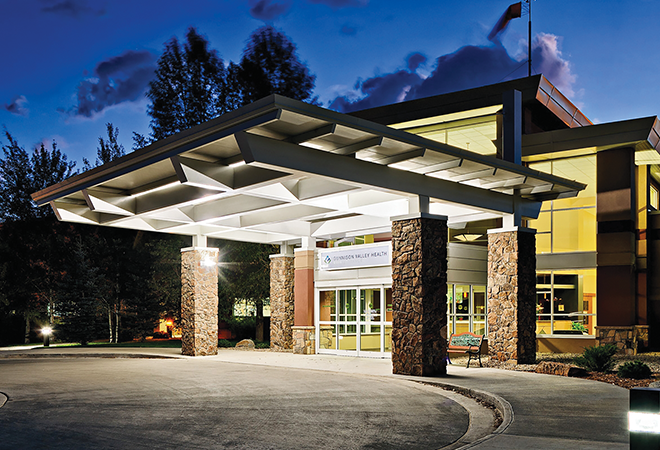Hoping for the best but planning for the worst
by Mark Reaman
There are 25 beds for patients in the Gunnison Valley Hospital. There are six total ventilators available with two more purchased but not yet delivered. As of Wednesday, March 18 there were four occupied beds in the hospital, 2 related to COVID-19, and no one using a ventilator. That is not expected to remain the case, given the outbreak of coronavirus in the county.
Gunnison Valley Health chief nursing officer Andrew Bertapelle said the spread of the coronavirus in Gunnison County is a “moving target that is changing day by day and hour by hour.”
The local facility is licensed as a 25-bed critical access hospital. “We do not have ICU [Intensive Care Unit] beds or capability,” Bertapelle said. “Right now, we have the appropriate emergency department and medical-surgical capacity, but don’t forget we take a lot of people with various medical conditions that have nothing to do with COVID-19. We generally have the facilities to address our needs and then some, but obviously this situation is a first.”
Bertapelle said the hospital staff and administration have made plans to address escalating situations and extra precautions are happening right now. “We don’t know what a surge of patients will look like,” he said. “We don’t want the Eagle County scenario I read about where there were 20 critical ICU patients with six beds.”
Normally, if someone comes into GVH needing ICU care, the local staff transfers them to a hospital that can handle the intensity of care, such as Grand Junction or the Front Range. Bertapelle explained that his staff contacts the potential receiving hospital and asks to be notified when an ICU bed is available, which generally, but not always, occurs pretty fast.
“So it happens all year long and there are times it can be a bit before a bed is open,” said Bertapelle. “That is, before the coronavirus. So we expect the bed availability will decrease and we are actively monitoring the status of hospitals in our area. That will be a challenge for us. We are hoping the community continues to do a great job with the social isolation piece and the vulnerable population within the community doesn’t get sick.”
The hospital does have a “surge plan” that has been developed, due to the circumstances. Bertapelle said the hospital is identifying alternative sites where patients can be placed. “It is similar to a huge national disaster we have trained for where patients will have to go to other places in the area. We are looking at all the options.
“The real limiting factor is the number of healthcare staff we have,” he continued. “Normally if we need extra help, we can usually call other Western Slope hospitals and get people. They do the same with us. But everyone is going through the same thing so staffing will be hard. We want to keep our staff safe, healthy and at work so we can flex up. That’s the goal.”
Bertapelle said looking at the cases and testing in the community is interesting since tests are being rationed so conservatively. He said the true prevalence of the virus in the community would be known if everyone were able to get a test. That isn’t possible because of the lack of testing kits.
“What we know is that the virus is prevalent in the community. The question now is how seriously people are taking the county order to stay isolated. If there are 3,000 vulnerable people in the community, that is who we are all trying to protect. That’s the risk focus. We will do what we can to deal with them when they come into the hospital, depending on the circumstances at the time and the severity of their symptoms.”
With basically six ventilators in the hospital, Bertapelle admitted the crisis comes when a seventh patient is in need of one. How long a person needs a ventilator is patient-specific. “The big fear is that it all comes at once and there aren’t enough beds and there aren’t enough ventilators. We hope and pray we don’t end up there, but we are definitely looking at all the resources available to us in the state.”
Bertapelle said the response from a community level has been incredible. “To be ahead of the curve is a good thing so we hope that puts us in a better place,” he said. “We are hoping for the best but planning for the worst. All the state officials who have observed what we are doing have said they’re impressed by what we’ve done and how we have coordinated our efforts.”
One success seen directly at the hospital is that the emergency department has been normalized with the creation of the screening stations and call center. “That has been very helpful to us,” he noted. “Things are normal in the ED since offsite screening stations were established.”
Bertapelle said being a part of the camaraderie has been amazing. “For me, it’s all about people coming together,” he reflected. “This is the time to come together. This is why I moved here, to be in a place where people support each other. Not everything will work perfectly but we are trying. Like C.J. [Malcolm, incident commander] said, we all need to give everyone some grace and we’ll come out better than some other communities in the state.
“Right now, we’re in a good place at the hospital,” he continued. “That could change when we’re done talking, however. As we’ve seen, things can change hour by hour, day by day.”
 The Crested Butte News Serving the Gunnison Valley since 1999
The Crested Butte News Serving the Gunnison Valley since 1999






